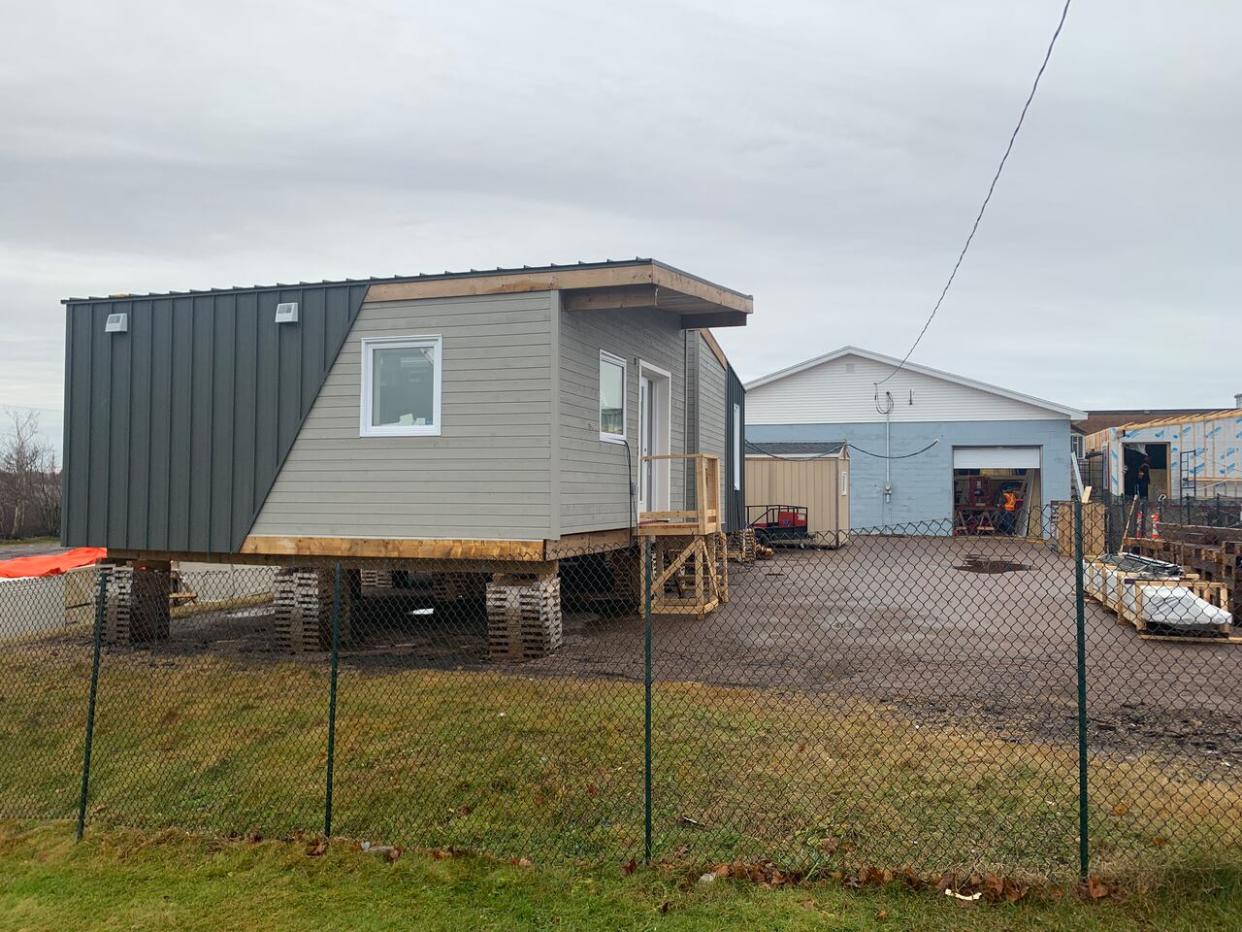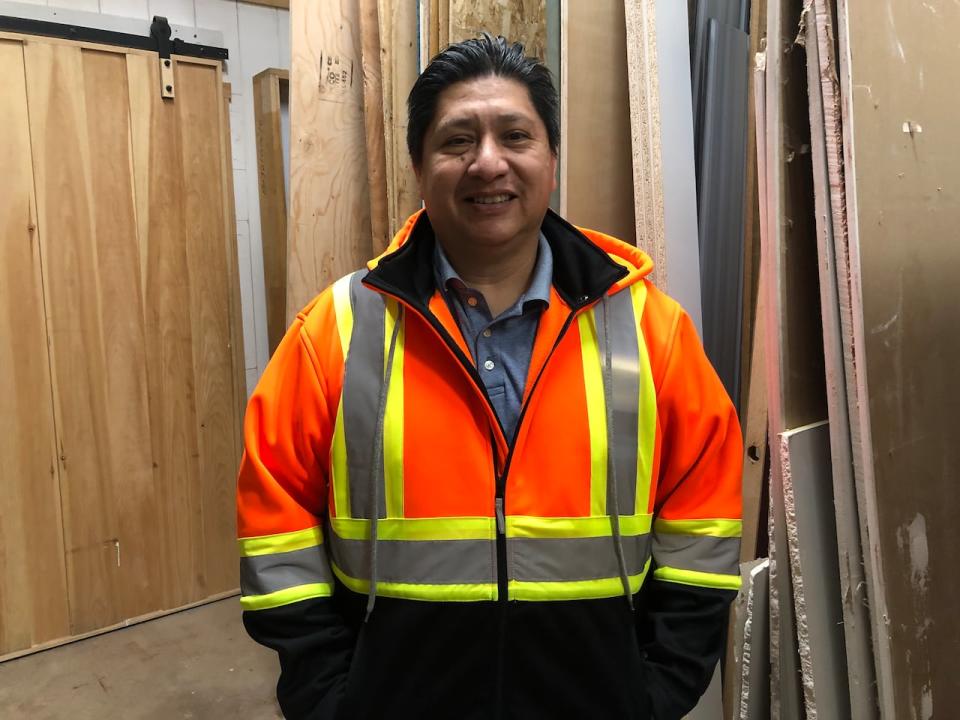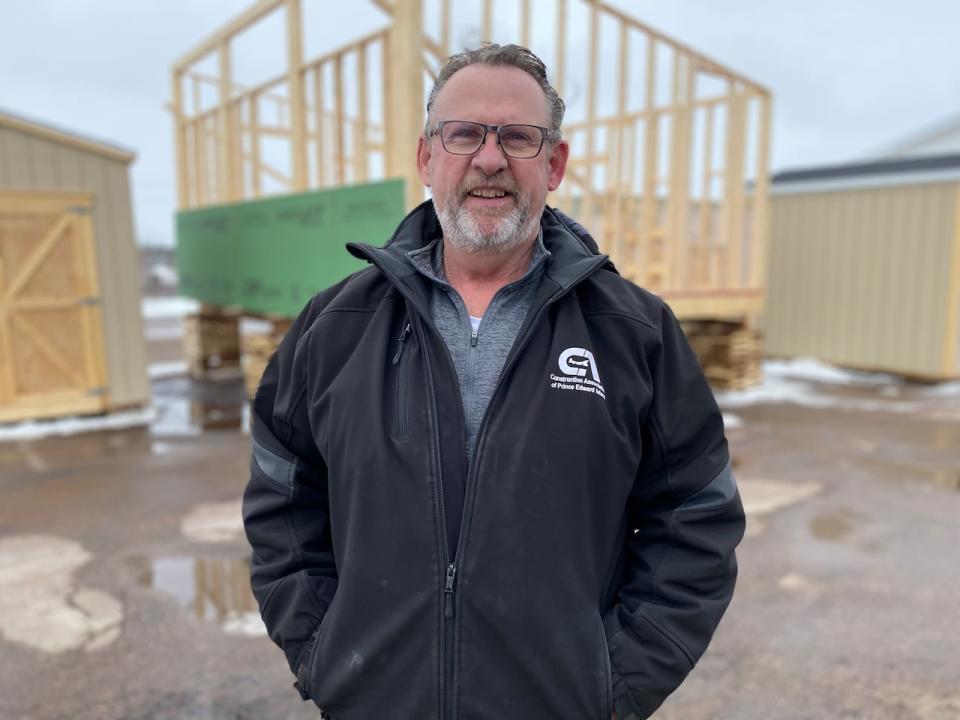In Charlottetown, newcomers and youth are building tiny homes to supply affordable housing

It doesn't look like there's enough room for three houses at the Construction Association of P.E.I.'s building site next to Charlottetown Rural High School — but there is. That's because the houses are tiny homes.
"We have two 300-square-footers plus one 500-square-footer," association general manager Sam Sanderson told CBC News on a recent visit.
The tiny homes will eventually become affordable housing as part of a provincial project. Right now, they're still being fitted with the most energy-efficient hardware possible.
Each building is net-zero ready, said Sanderson.
"In the simplest terms, it's very easy to heat. It uses very little energy to heat and cool, and it's good for the environment," he explained.
That requires high R-values for insulation on the walls, floor and ceiling to retain heat, and audits from the province to make sure every possible way to save energy has been considered.
"Everything about them screams energy efficiency," Sanderson said.

Students in the Construction Association's training programs have hands-on classroom experience before going to work placements. (George Melitides/CBC)
Inside each of the tiny homes is enough space for a bedroom — or two, in the case of the 500-square-foot ones — a kitchen, a living room and a bathroom with a shower or bath. All the normal appliances will be brought in, including fridge, stove, washer and dryer.
"It's small, it's unique, it's innovative, but it's also very easy to maintain," Sanderson said. "And your long-term care costs are certainly much, much less than your traditional home."
Building houses and skills
Construction began on the first of the tiny homes back in March 2023. They are taking longer than usual to build, but that's for a good reason: They are being built by students.
The construction association has two training programs that run side by side, one aimed at skilled newcomers to Canada and the other at youth considering a construction career. Under supervision from a handful of industry professionals, students in both programs have been doing the work on the homes.

After building his own house in China, Zhaojie Wang wants to get into construction in Canada. (Victoria Walton/CBC)
One of those students is Zhaojie (Jerry) Wang, who moved to P.E.I. from China four years ago. He was an engineer at home, but says he's always liked construction.
"Before I went to Canada, I built my own house, and I want to try electrician, carpenter or other fields. I like to try new things," said Wang.
Wang said he's learned a lot in the program, including the ways in which carpentry is different in Canada.
"In China, we use our hand most of the time. But here there's more tools to help you," he said.

Jaime Tinoco worked in I.T. in Mexico but hopes to go into a trade on Prince Edward Island through the program. (Victoria Walton/CBC)
Jaime Tinoco, who came to P.E.I. from Mexico five years ago, has had a similar experience.
"It's totally different than our countries. In Mexico we don't use wood for construction, we use blocks and cement," he said.
Tinoco was working in I.T., but has always had a passion for construction as well. He is now working toward the goal of getting his Red Seal electrician certification.
After the classroom and hands-on time with the Construction Association ends, the students will have eight weeks of on-the-job training.
"Then maybe in the future, I have my own company," Tinoco said.
Learning from each other
The students in the Youth in Construction program also have the opportunity to learn from the skilled newcomers.
"I thought it'd be a little intimidating having some of the newcomers who have a little bit more experience, but they're just as helpful as the teachers," said 24-year-old Jacob Stevenson from Cornwall.

Jacob Stevenson was a cook before the program. Now he hopes to take up painting. (Victoria Walton/CBC)
Stevenson says he had "very minimal" experience in carpentry and was a cook before taking the program.
"It didn't really make me a lot of money," he said of his previous career. "So I decided, 'Let's get into a little bit of a better trade here.' Construction seems to be a very prolific thing on the Island here. I just want to expand my horizons."
Dominick Hughes, 24 and from Charlottetown, also wanted to expand his horizons in the trades. He was a painter before this, so that's been his main contribution to the tiny homes, but Hughes next wants to learn to drywall.

Dominick Hughes is hoping he can learn to drywall and find an apprenticeship that turns into a job. (Victoria Walton/CBC)
"They're going to be setting us up with different employers to try all the different trades that we're interested in to see which would be our best fit and what we're most comfortable with," Hughes said.
"I plan on doing probably a couple of them to try out a couple different things to make sure that where I'm going is where I want to go."
The association is also working to train even younger students in construction skills at high schools across P.E.I., including Colonel Gray, Bluefield, Three Oaks and Morell High.
Ready to go
Sanderson said he doesn't mind that the tiny homes on the Charlottetown site are taking longer to build, if it means training new people in the process at a time when construction workers are hard to come by right across the province.
"We're not speed building here," he said.

Sam Sanderson of the Construction Association of P.E.I. says he's hearing from his counterparts across the country who are interested in the tiny homes project. (Kirk Pennell/CBC )
The agreement with the province is to build up to 35 of those tiny homes and place them on an appropriate site or sites.
"We are going to be moving these to another area of our site here and stockpiling them until the property is ready," Sanderson said of the three homes under construction at the moment. "Once the property is ready, it'll be a very quick transition to get the first one on the site."
He expects that will happen around summer time, but it could be sooner.
In a statement to CBC News, a representative from the P.E.I. Department of Housing said the province estimates the first of the tiny homes will be delivered sometime in spring 2024.

The youth and newcomer program participants spend six weeks in the classroom before going out to the job site. (Victoria Walton/CBC)
"The province continues to work on the plan for the location of the tiny homes but at this time, it has not been finalized," the statement said.
At a time when construction — and construction workers — are needed more than ever, Sanderson has heard from many of his counterparts that this program could be part of the solution to Canada's housing crisis.
For him, there's no "could be" about it.
"I think it is for sure," he said.


